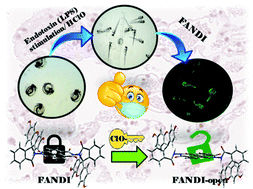Shrabani Saha, Sujoy Das, Sriparna Das, Anwesha Samanta, Sudipta Maitra and Prithidipa Sahoo
Org. Biomol. Chem., 2020,18, 6716-6723
DOI:
10.1039/D0OB01389G,
Paper
An innovative fluorescein appended naphthalene diimide based probe (FANDI) has been prepared and characterized to selectively recognize hypochlorite or ClO− ions in the presence of other reactive oxygen species (ROS) and biorelevant ions, using a unique chemodosimetric method. Hypochlorite induced oxidation can efficiently alter the initial photophysical properties of FANDI and shows an easily detectable “turn on” green fluorescence. The chemodosimeter FANDI can efficiently detect exogenous as well as endogenous ClO− ions in RAW 264.7 cells (macrophages) and zebrafish embryos (Danio rerio) which further ensures the high potential, easy cell permeability and photostability of FANDI and makes it worth exploring in the future.
